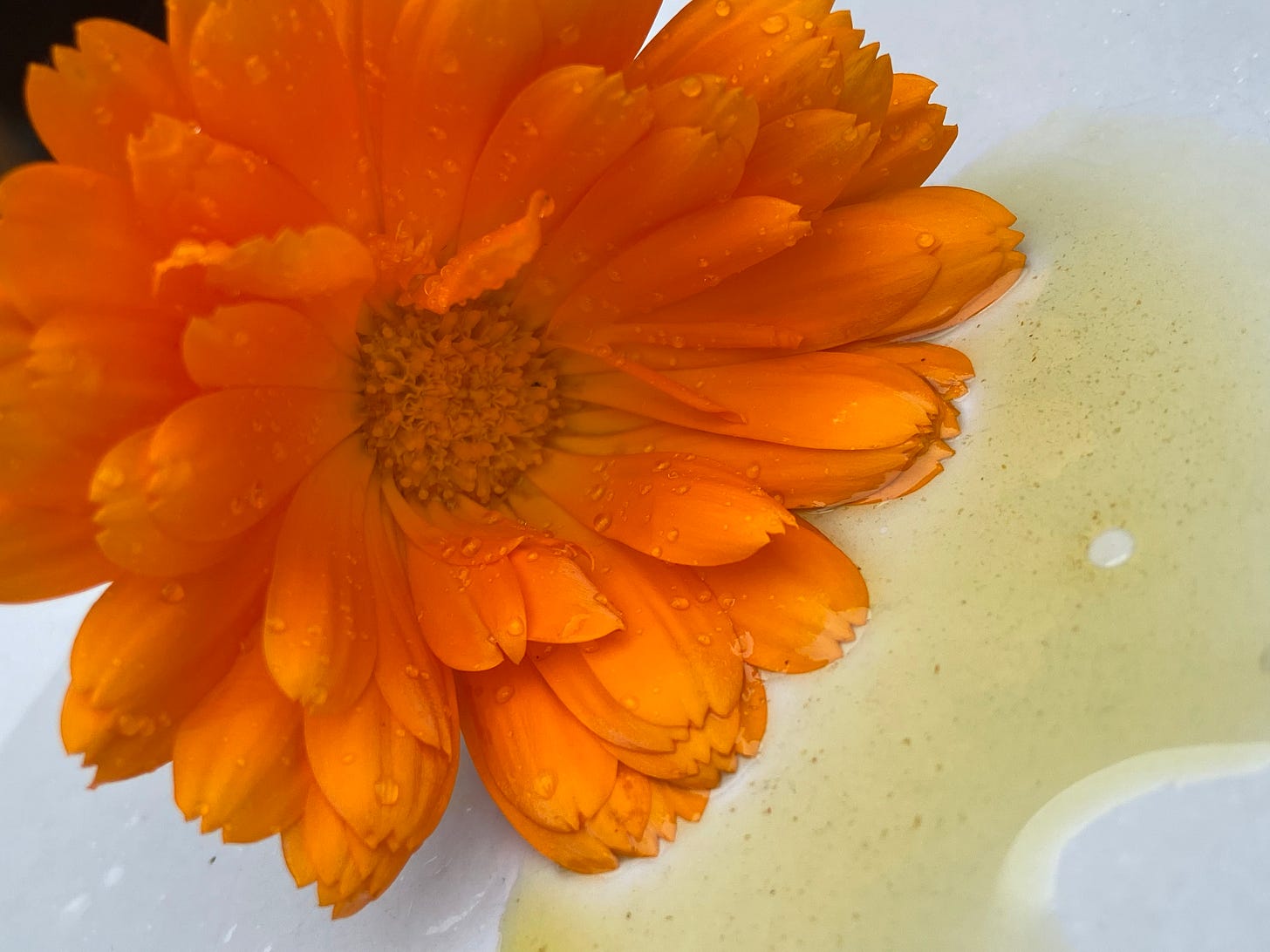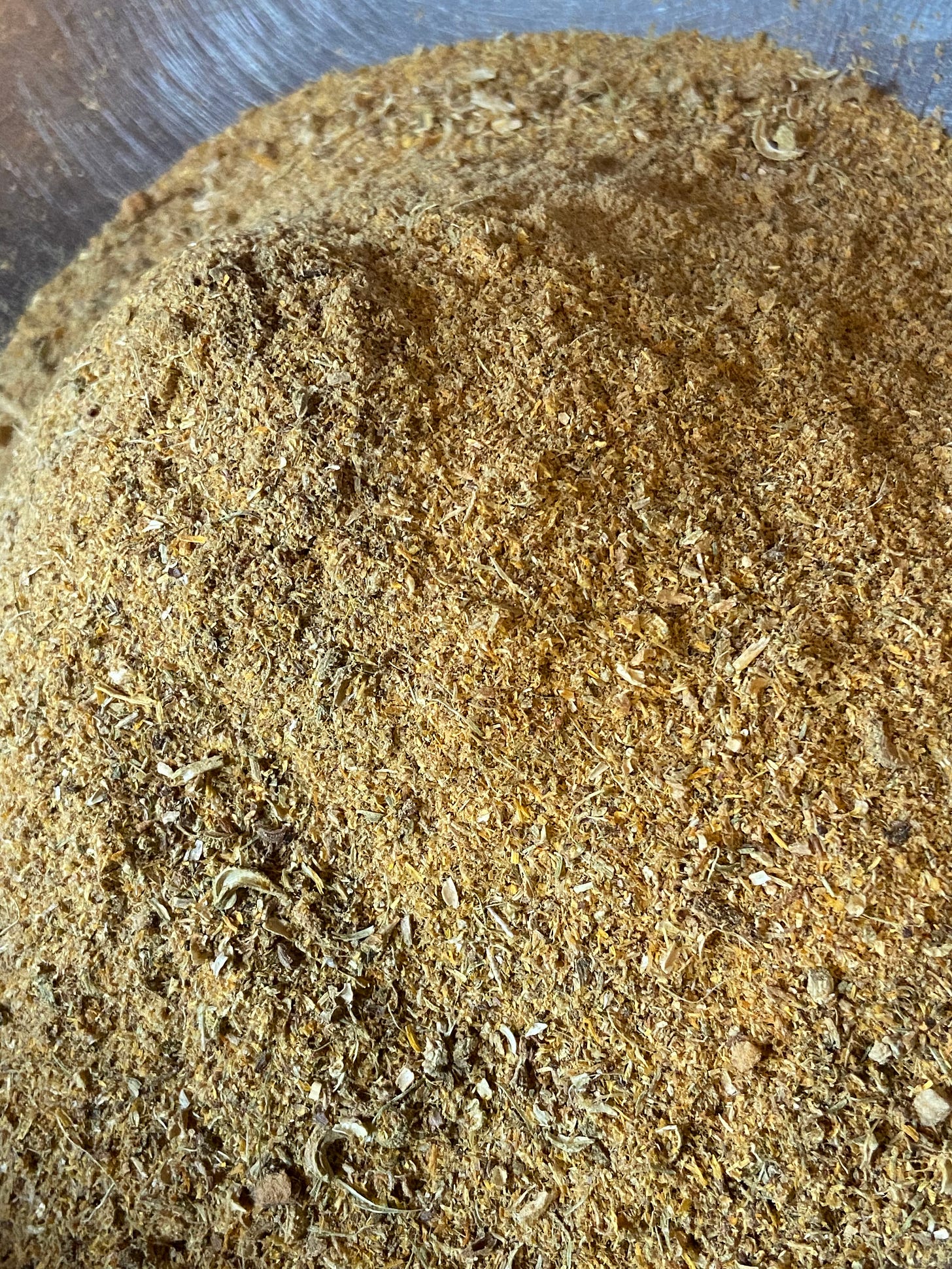I’ve been making small tins of Boo Boo Salve annually for many, many years now. I’ve consistently gotten positive feedback for its effectiveness in relieving itching from bug bites and helping to heal small cuts and scrapes. That feedback includes ameliorating rashes of one kind or another, though that wasn’t its intended purpose. I personally enjoy using it for cuticle care, popping it out of my purse in down moments when I’m out and about.
A really great salve starts with a really great base, and that base is the infused plant oil. I’m thankful that I learned from Kami McBride how to make infused oils that actually look and smell like the plants themselves. Your green plant oils, indeed your salves made from them, should not look beige or smell only like beeswax. Granted, if you’re using olive oil, you may end up with a green tint, but it’s nothing like the green you get with properly infused plant material.
To begin with, I powder my dried herbs. I don’t use fresh herbs for making oil, other than when I’m blessed with fresh picked St. John’s wort. Using fresh plant material can add excess water into the oil and cause the oil (and therefore your salve) to go bad rather quickly. I like the salves I make to last about a year, and I usually make them in the summer time. I use my Vitamix to powder my herbs. For calendula oil, I use 1 ounce dried to 7 ounces of oil, so that is something to keep in mind if you make your own. Don’t attempt to powder bunches of ounces of herb if you don’t want to be preparing a massive amount of oil (not that that would be a bad thing…).
I put my powdered herbs into a bowl, and rehydrate them with a little bit of vodka, just enough to feel like slightly damp sand, and then cover and sit overnight. This is something I want to experiment with, because although this was how I was taught, it does make me wonder if reHYDRATING a dry herb actually creates a noticeably more potent product. I also wonder if the water content of the vodka itself might be potentially problematic, although I’ve never had a salve go rancid within that first year. I’m not sure how to test this without getting a lab involved, however.
Anyhow, the next day, I put my rehydrated herbs back into the blender, add my measured oil, and blend again until slightly warm to the touch. I do this several times a day for a couple of days (it puts my blender out of use for other things during that time, but I think it’s worth it!).
I’ve used many different kinds of oils for my salves, and usually end up using more than one kind. Olive oil is the least expensive and does well, but other oils are just as useful for one reason or another. Sesame oil is very light and absorbs into the skin readily, for example. Apricot kernel oil is also highly absorbant, and is the oil I chose to use this year to infuse my calendula in for its anti-inflammatory benefits. It’s the first time I’m using this oil, and because I want to be careful about people with sensitive skin, I’ll definitely be using other oils for the other herbs I add into my salve this year.
When finished steeping and blending, I strain my oil through a tightly woven cheesecloth, kneading it and finally getting as much out as I can with a potato ricer (I use this one). I wouldn’t knead and press my oil if the herbs were fresh, however, because of their water content. Kami uses muslin to strain, but I find that more difficult to use, not to mention I’m far too impatient. I actually don’t mind at all wee bits of herb in my oil, as you can make out in the photo up top.
The finished oil has a lovely color and aroma. A properly prepared oil can last up to a year in a dark and dry place, or even longer if refrigerated. I use amber bottles to store my oils in, properly labelled with the herb, oil, and date pressed. I also prefer to infuse my oils with single herbs, and blend up whatever I’m making from the finished oils rather than mixing many herbs at the start into one infusion. That way, I can make the proportions what I like for whatever I am creating.
There are many ways to make herb preparations, and no one has the one, right way. As long as you end up with something concentrated and clean, you’ve probably met your goal. Coming up: making the salve itself!
If you’d like to dive in deeper and learn from Kami herself, you can find her course on oils HERE.
Benevolent Healer endeavors to encourage, empower, and equip others who desire to educate, feed, and heal themselves, their families, and their communities using food and plants as medicine.






What parts of the Calendula do you dry? Petals? Seeds? Picked green or dry? stems? Leaves? I see at least one seed in your photo of the powdered herb.
My 17 year old son made a dandelion is fused oil and then salve this spring. I’ve wanted to try forever but had r worked up the courage. He watched a couple videos and did it! I was very impressed! Thanks for the directions you use, I’ll share it with him also. We’re going to make a plantain salve with some other things in it soon. 💕